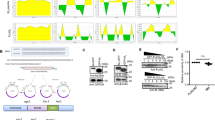Abstract
Epitope tagging is a valuable tool for quick detection, isolation, and analysis of protein-protein interaction, without prior knowledge of the target protein. The FLAG epitope tag, one of the most widely used tags, is an eight amino acid peptide that can be detected by anti-FLAG monoclonal antibody. In the present study, we have examined the detection sensitivity of a protein fused to three tandem FLAG epitopes by Western blot analysis, immunoprecipitation, and immunohistochemical analysis using anti-FLAG® M2 antibody. We find that the triple FLAG epitope significantly enhances the sensitivity of detection of fusion protein expressed in mammalian cells.
Similar content being viewed by others
References
Munro, S. and H. Pelham, (1987) A C-terminal signal pevents secretion of luminal ER proteins. Cell 38, 899.
Field, J., Nikawa, J., Broek, D., et al. (1988) Purification of an RAS-responsive adenylyl cyclase complex from Saccharomyces cerevisiae by use of an epitope addition method. Mol. Cell. Biol. 8, 2159.
Kolodziej, P. A. and Young, R. (1991). Epitope tagging and protein surveillance. Methods Enzymol. 194, 508–519.
Finley, D., Bartel, B., and Varshavsky, A. (1989) The tails of ubiquitin precursors are ribosomal proteins whose fusion to ugiquirin facilitates ribosome biogenesis. Nature (London) 338, 394–401.
Hopp, T. P., Prickett, K. S., Price, V. L., et al. (1988) A short polypeptide maker sequence useful for recombinant protein identification and purification. BioTechnology 6, 1204–1210.
Brizzard, B., Chubet, R., and Vizard, D. (1994) Immunoaffinity purification of FLAG epitope-tagged bacterial alkaline phosphatase using a novel monoclonal antibody and peptide elution. BioTechniques 16, 730–735.
Slootstra, J. W., Kuperus, D., Pluckthun, A., and Meloen, R. H. (1997). Identification of new tag sequences with differential and selective recognition properties for the anti-FLAG monoclonal antibosides M1, M2, and M5. Mol. Divers. 2, 156–164.
Hernan, R., Heuermann, K., and Brizzard, B. (2000) Multiple epitope tagging of expressed proteins for enhanced detection. BioTechniques, 28, 789–793.
Author information
Authors and Affiliations
Corresponding author
Rights and permissions
About this article
Cite this article
Zhang, L., Hernan, R. & Brizzard, B. Multiple tandem epitope tagging for enhanced detection of protein expressed in mammalian cells. Mol Biotechnol 19, 313–321 (2001). https://doi.org/10.1385/MB:19:3:313
Issue Date:
DOI: https://doi.org/10.1385/MB:19:3:313




